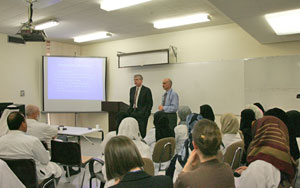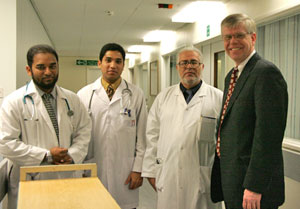Senior Pediatric Faculty Visit HMC, WCMC-Q

Dr. Loughlin delivered a lecture on bronchiolitis at HMC.
A series of ward rounds, visits to neonatal and pediatric intensive care units, and discussions with physicians and residents at Hamad Medical Corporation (HMC), as well as meetings at WCMC–Q, marked the visit to Doha early February of Gerald Loughlin, M.D., chairman of pediatrics, and Lyuba Konopasek, M.D., director of the pediatric clerkship, at WCMC–NY.
"We really felt we wanted to be in the trenches and to see what‘s going on," said Dr. Loughlin, "We made rounds, went to several of the residents’ conferences, met with individual leaders, and got a chance to ask questions. It was very much a working visit."
Dr. Loughlin, who is also Nancy C. Paduano Professor of Pediatrics at WCMC-NY and pediatrician–in–chief at NewYork–Presbyterian Hospital, delivered a lecture on bronchiolitis and presented Grand Rounds on obstructive sleep apnea syndrome in children during his visit.
Interviewed later, Dr. Loughlin noted that the approach to pediatric care in Qatar differs from that in the U.S. What is termed 'well child care' is the province of family physicians in primary healthcare clinics in Qatar; pediatricians normally only see children when a referral is necessary — and they tend to be specialists in a particular subspecialty.
In the U.S. model, a general pediatrician provides 'well child care' and follows a child’s development. The advantage of this system is that it provides continuity of care, and the physician is more likely to pick up any underlying health problems that may emerge over a period of time.

Dr. Loughlin joined HMC pediatricians for ward rounds.
In addition, the definition of pediatrics encompasses both children and adolescents, since patients are followed up to the age of 21 years; this contrasts with Qatar, where the upper age limit is now 14 years, said Dr. Loughlin. The extended age range of patients in the U.S. enables pediatricians to follow children with chronic illnesses such as diabetes, cystic fibrosis and congenital heart disease, through adolescence to adulthood.
Experience of adolescent medicine is a requirement of every medical student's and pediatric resident's training in the U.S., he added.
Dr. Konopasek, who is also assistant professor of pediatrics at WCMC–NY, explained: "A six–week clerkship in general pediatrics is part of the clinical education of all third-year medical students at Weill Cornell in New York. Those six weeks are split between time in the emergency room, the well–baby nursery, the inpatient service and outpatient clinics."

Dr. Konopasek
With clinical clerkships for WCMC–Q medical students set to start in fall 2006, February’s meetings with chairperson of pediatrics at HMC, Dr. Ghalia Bint Mohammed Al–Thani, and members of the pediatric team, provided an important opportunity to discuss the arrangements for providing a comparable experience in Doha.
The WCMC–Q clerkship director will work closely with colleagues at HMC to establish a pediatric clerkship similar to that organized in New York, Dr. Konopasek said.
Dr. Konopasek and Dr. Loughlin noted both the commitment of the HMC leadership to ensure the success of the clerkship and the enthusiasm of the physicians. "We met a number of very talented physicians. We feel confident that, as we work together, we’re going to be able to provide an excellent experience for our students here," Dr. Konopasek said.
In presenting Grand Rounds on obstructive sleep apnea syndrome (OSAS) in children, Dr. Loughlin focused on what he described as "an evolving problem" in pediatrics. He has been at the forefront of work in this area since treating a child that was repeatedly brought to the emergency for trouble breathing during sleep room during his time at the University of Florida in the 1970s.
Worldwide, approximately 10% of children snore loudly at night. Of these, approximately 1-3% have of OSAS. Enlarged adenoids or tonsils, a congenital malformation of the jaw or face, or obesity, coupled with a problem controlling breathing during sleep, result in this breathing disorder. This may have serious consequences, including cor pulmonale (strain on the right side of the heart) and, eventually, heart failure.
However, recent research suggests that snoring and disrupted sleep patterns may negatively affect a child’s development, notably in terms of neuro–cognitive function, leading to poor scores in math, spelling and science assessments.
Interviewed later, Dr. Loughlin commented: "Snoring has always been the subject of comedians — but rather than being treated as a joke, it turns out that it probably needs to be considered the same way as you’d consider a child who is wheezing — a sign of airway obstruction. It has profound effects on growth and development, cardiac function and neurologic function." Treatment of OSAS includes removal of adenoids and tonsils if they are enlarged, although this is not recommended for infants below 2 years of age. In addition, education about nutrition, to prevent children from becoming obese, will have a role.
Dr. Loughlin summarized the need for more research: "In children up to 3 or 4 years old, half their life is spent in another world (i.e. asleep), and we don’t know very much about that 'other world.' It's probably more important to know what’s going on when they’re asleep than when they’re awake and everyone is watching them."
